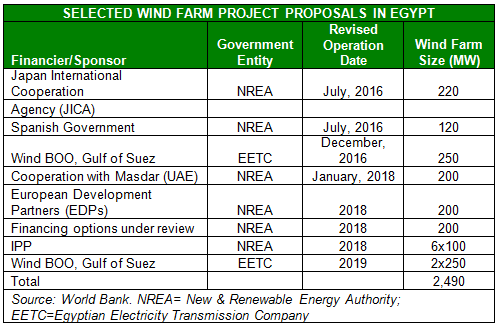Egypt generated 12.9-billion kilowatt per hour from hydroelectricity, mostly from Aswan High Dam and the Aswan Reservoir Dams, but analysts believe much of the area’s hydropower potential has been exhausted.
A solar-thermal power plant located in Kuraymat, 100 kilometers from Cairo, generates around 140 MW of solar-thermal energy, saving 5,000 tons of natural gas per year, or 180,000 tons CO2 each year.
The country’s New & Renewable Energy Authority (NREA) is looking to meet 20% of the country’s electric energy demand via renewable energy resources by 2020, including about 12% from wind power, 8% from other renewable energy sources such as hydro power and solar energy.
NREA has plans to implement projects with combined capacity of 2,370 MW in wind power alone, but the projects have been delayed due to political turmoil. Analysts believe USD 4.5 billion in investments will be needed to build the new wind power infrastructure.
“The implementation of all (public and private) wind projects in the Gulf of Suez area has incurred delays due to the 2011 revolution and unstable country transition thereafter,” according to the World Bank, which is funding some of the projects.
“However, these delays and changes to the plan will only defer the commissioning date of wind farms. In other words, the Government of Egypt is still committed to work with development institutions and private sector to address the obstacles of implementing the wind projects in the Gulf of Suez region.”
To fast track the projects, the government is considering a wind commercialization program focused on attracting the private sector. The different public and private business models include private Build, Own, Operate, (BOO) projects, feed-in-tariffs for small projects, public projects, auto-generation and joint ventures.
“The program targets to achieve competitive electricity tariffs through an international tender and stimulate private investment from international and local investors into Egypt’s power sector. Transmission infrastructure to evacuate the additional capacity is an essential prerequisite to private sector participation in the wind commercialization program.”
As the political uncertainty fades in the country, the power sector is expected to take greater prominence as it is key to the economy’s revival.
Egypt’s power demand is expected to grow 6% per annum over the next seven years, but the country needs to invest heavily in the sector to meet rising demand.
It will certainly be a tall order. The Energy Sector Management Assistance Program (ESMAP) estimates that the country needs USD 21 billion in power infrastructure investment over the next seven years to catch up with soaring domestic demand for power.
Egypt is also expected to face a serious challenge in the coming years, as its natural gas production is increasingly being diverted to satisfy domestic demand, resulting in loss of precious export revenues. Indeed, the country is no longer in a position to keep its international commitment to supply liquefied natural gas.
The Egyptian government is encouraging the transfer of some oil consumption towards the use of natural gas for power generation. In addition, cuts on electricity subsidy should curb energy consumption and help the government cut its energy subsidy bill by USD 6 billion.
Apart from the economic considerations, other factors are also at work, compelling Egypt to move away from fossil-fuel driven power sector.
“Egypt ranks among the 11 countries in the world showing the fastest-growing greenhouse gas emission,” the World Bank said. “The analysis undertaken as part of the National Strategy Studies (NSS) in 2002 indicates that by 2017 emissions could reach more than three times the 1990 levels.”
In the electricity sector, the Government recognizes that the power system in Egypt needs to grow in tandem with the economy with the early lower cost transmission investments providing an important enabling function for competitive investments in generation.
“Even with somewhat lower electricity consumption growth rate in comparison with the GDP growth — to allow for energy efficiency improvement – the needs for new investments in the power generation, transmission and distribution are very significant.”
The private sector, international organizations, and renewable energy funds such as the World Bank’s Clean Technology Fund have all provided investment in the sector, but more needs to be done.
Egypt is also exploring renewable and alternative energies to meet rising energy demands. Indeed, president Abdul-Fattah Al Sisi earmarked the 1,000-megawatt (MW) El-Dabaa nuclear power facility as a priority project in his first speech as head of state.
While bidding for the plant was expected to have started in 2011 with a completion date of 2019, the project has been mired in dispute over landownership and general political malaise. Getting the project would not only require financial muscle, but also political will from the Egyptian authorities.



